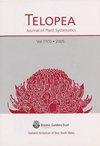标题昆士兰约克角半岛小叶蝉群的一新种托叶蝉
IF 0.5
4区 生物学
Q4 PLANT SCIENCES
引用次数: 1
摘要
在澳大利亚北部的热带地区,有14个Drosera物种在petiolaris复合体中被识别出来。该复合体位于Lasiocephala部分;一种多年生茅属植物,主要特征是叶柄上有一层由白色毛组成的毛被。在这里,我们描述了一个新的物种,D.托aris Baleeiro, R.W.Jobson和R.L.Barrett,它只在昆士兰约克角半岛的白沙栖息地被发现。该新种与d.p eolaris R.Br有亲缘关系。前女友。和d.l anata k.k kondo。本文章由计算机程序翻译,如有差异,请以英文原文为准。
Drosera stipularis, a new species for the D. petiolaris complex from Cape York Peninsula, Queensland
Across tropical northern Australia 14 Drosera species are recognised within the D. petiolaris complex. The complex is placed in section Lasiocephala; a group of perennial sundews mostly characterised by an indumentum of white hairs upon the petiole. Here we describe a new species for the complex, D. stipularis
Baleeiro, R.W.Jobson & R.L.Barrett, which is known only from white-sand habitats on Cape York Peninsula, Queensland. The new species is allied to D. petiolaris R.Br. ex DC. and D. lanata K.Kondo.
求助全文
通过发布文献求助,成功后即可免费获取论文全文。
去求助
来源期刊

Telopea
PLANT SCIENCES-
CiteScore
1.30
自引率
42.90%
发文量
0
期刊介绍:
Manuscripts submitted for publication in TELOPEA are published online, after peer review and acceptance by the TELOPEA Editorial Committee and when final editorial formatting has been completed. The journal specialises in plant systematics and phylogeny. The geographic scope of the journal encompasses Australia, Malesia, Melanesia, Micronesia, and Polynesia. The suitability of a work for the journal depends on the topic and the region of origin, generally the narrower the focus of the manuscript the closer to New South Wales must be its geographic focus.
As a general guide, we will consider:
1) revisionary treatments and other substantial bodies of work from any of the regions mentioned above.
2) new species from any Australian state.
3) new country records for Australia from any state.
4) new state records from New South Wales only.
However, we aim to support botanical research across the broader Australasian and Pacific region, and will consider submissions on their merit.
Generally we will not consider extraterritorial new country records, or single lectotypification papers unless they pertain to New South Wales taxa, or have significant bearing on the Australian flora.
 求助内容:
求助内容: 应助结果提醒方式:
应助结果提醒方式:


